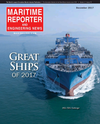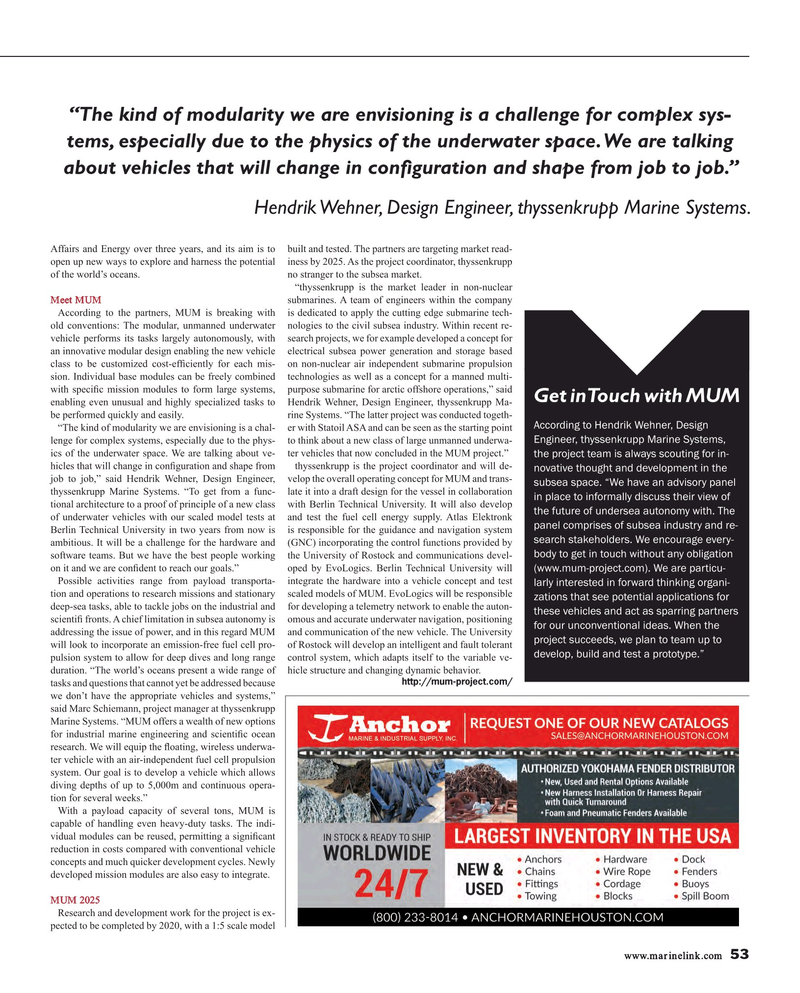
Page 53: of Maritime Reporter Magazine (December 2017)
U.S. Navy Quarterly
Read this page in Pdf, Flash or Html5 edition of December 2017 Maritime Reporter Magazine
“The kind of modularity we are envisioning is a challenge for complex sys- tems, especially due to the physics of the underwater space. We are talking about vehicles that will change in con? guration and shape from job to job.”
Hendrik Wehner, Design Engineer, thyssenkrupp Marine Systems.
Affairs and Energy over three years, and its aim is to built and tested. The partners are targeting market read- open up new ways to explore and harness the potential iness by 2025. As the project coordinator, thyssenkrupp of the world’s oceans. no stranger to the subsea market.
“thyssenkrupp is the market leader in non-nuclear
Meet MUM submarines. A team of engineers within the company
According to the partners, MUM is breaking with is dedicated to apply the cutting edge submarine tech- old conventions: The modular, unmanned underwater nologies to the civil subsea industry. Within recent re- vehicle performs its tasks largely autonomously, with search projects, we for example developed a concept for an innovative modular design enabling the new vehicle electrical subsea power generation and storage based class to be customized cost-ef? ciently for each mis- on non-nuclear air independent submarine propulsion sion. Individual base modules can be freely combined technologies as well as a concept for a manned multi- with speci? c mission modules to form large systems, purpose submarine for arctic offshore operations,” said
Get in Touch with MUM enabling even unusual and highly specialized tasks to Hendrik Wehner, Design Engineer, thyssenkrupp Ma- be performed quickly and easily. rine Systems. “The latter project was conducted togeth-
According to Hendrik Wehner, Design “The kind of modularity we are envisioning is a chal- er with Statoil ASA and can be seen as the starting point
Engineer, thyssenkrupp Marine Systems, lenge for complex systems, especially due to the phys- to think about a new class of large unmanned underwa- ics of the underwater space. We are talking about ve- ter vehicles that now concluded in the MUM project.” the project team is always scouting for in- hicles that will change in con? guration and shape from thyssenkrupp is the project coordinator and will de- novative thought and development in the job to job,” said Hendrik Wehner, Design Engineer, velop the overall operating concept for MUM and trans- subsea space. “We have an advisory panel thyssenkrupp Marine Systems. “To get from a func- late it into a draft design for the vessel in collaboration in place to informally discuss their view of tional architecture to a proof of principle of a new class with Berlin Technical University. It will also develop the future of undersea autonomy with. The of underwater vehicles with our scaled model tests at and test the fuel cell energy supply. Atlas Elektronk panel comprises of subsea industry and re-
Berlin Technical University in two years from now is is responsible for the guidance and navigation system search stakeholders. We encourage every- ambitious. It will be a challenge for the hardware and (GNC) incorporating the control functions provided by body to get in touch without any obligation software teams. But we have the best people working the University of Rostock and communications devel- on it and we are con? dent to reach our goals.” oped by EvoLogics. Berlin Technical University will (www.mum-project.com). We are particu-
Possible activities range from payload transporta- integrate the hardware into a vehicle concept and test larly interested in forward thinking organi- tion and operations to research missions and stationary scaled models of MUM. EvoLogics will be responsible zations that see potential applications for deep-sea tasks, able to tackle jobs on the industrial and for developing a telemetry network to enable the auton- these vehicles and act as sparring partners scienti? fronts. A chief limitation in subsea autonomy is omous and accurate underwater navigation, positioning for our unconventional ideas. When the addressing the issue of power, and in this regard MUM and communication of the new vehicle. The University project succeeds, we plan to team up to will look to incorporate an emission-free fuel cell pro- of Rostock will develop an intelligent and fault tolerant develop, build and test a prototype.” pulsion system to allow for deep dives and long range control system, which adapts itself to the variable ve- duration. “The world’s oceans present a wide range of hicle structure and changing dynamic behavior.
http://mum-project.com/ tasks and questions that cannot yet be addressed because we don’t have the appropriate vehicles and systems,” said Marc Schiemann, project manager at thyssenkrupp
Marine Systems. “MUM offers a wealth of new options for industrial marine engineering and scienti? c ocean research. We will equip the ? oating, wireless underwa- ter vehicle with an air-independent fuel cell propulsion system. Our goal is to develop a vehicle which allows diving depths of up to 5,000m and continuous opera- tion for several weeks.”
With a payload capacity of several tons, MUM is capable of handling even heavy-duty tasks. The indi- vidual modules can be reused, permitting a signi? cant reduction in costs compared with conventional vehicle concepts and much quicker development cycles. Newly developed mission modules are also easy to integrate.
MUM 2025
Research and development work for the project is ex- pected to be completed by 2020, with a 1:5 scale model www.marinelink.com 53
MR #12 (50-57).indd 53 MR #12 (50-57).indd 53 12/6/2017 4:17:14 PM12/6/2017 4:17:14 PM

 52
52

 54
54
